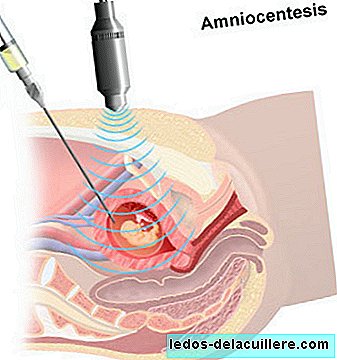
Amniocentesis is the prenatal test that is most frequently used when ruling out congenital diseases. Consists in remove a sample of amniotic fluid, which is the liquid that surrounds the fetus during its intrauterine life, which protects and nourishes it.
It is done by pricking the pregnant abdomen with a needle, controlling by ultrasound control that the technique is performing well. The placenta is crossed and about 20 milliliters of the amniotic fluid around the baby is removed. It does not affect the child, since this amount is replenished in 24 hours.
It is not done to all pregnant women, but only in selected cases, it is also optional, and parents have every right to refuse its realization, after considering risks and benefits.
It is offered to risk pregnancies, the most frequent case is pregnant women over 35-40 years since it is proven that the probability of the child having Down syndrome of 1 among 1250 newborns in those under 30 years of age is significantly increased. 1 of 400 in those over 35 and 1 in 100 in those over 40. Other cases in which this test is indicated is when any abnormality is detected in screening tests such as ultrasound or blood tests, or when there is a family history or pregnancy with congenital malformations.
It can be done after 10 weeks of gestation, although it is usually done between 16-20 weeks. According to the event, it will be considered:
- Early amniocentesis: when performed between 12-16 weeks. This usually occurs in pregnancies of mothers with more than 35 years or when there is a history of genetic alterations in any of the parents or in previous pregnancies.
- Late: after 32 weeks, it serves to measure the degree of lung maturity of the baby, or as a treatment in polyhydramnios (when there is more fluid than necessary and should be extracted to regulate the situation), or other pathologies.
From the liquid that is achieved, various components are analyzed in order to detect different anomalies:
Alphafetoproteins: its increase suggests neural tube defects (spinal cord malformation), anencephaly, abdominal wall alteration, renal and intestinal disorders. Acetylcholinesterase: its presence also indicates possible neural tube defect. Bilirubin: increases if there is destruction of the blood (hemolysis), how it occurs in cases of incompatibility of blood group between mother and baby. Pulmonary surfactant: indicates the degree of lung maturity. Fetus cells: to analyze chromosome alterations. For example, it detects multiplication of chromosomes as occurs in Down syndrome. DNA: to rule out genetic mutations. Risks: It can be mildly painful or annoying. Between one and two percent of women feel cramps, small losses of blood or amniotic fluid. After the procedure a few days of relative rest is recommended. It is considered a safe technique. The risk of abortion is around 0.5%. There is also a minimal risk of getting a uterine infection.
It must be taken into account that in a very small number of cases a sufficient or effective sample is not obtained, and it may be necessary to repeat the test.












